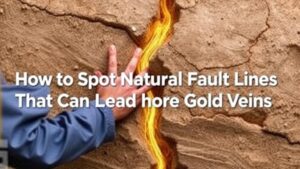How to Locate Untouched Gold Deposits Near Well-Known Claims
How to Locate Untouched Gold Deposits Near Well-Known Claims
The quest for gold has captivated humanity for centuries. As resource scarcity intensifies, the focus has shifted toward identifying untouched gold deposits, particularly in areas near established claims. This article explores effective strategies to locate these deposits, leveraging historical data, geological surveys, and modern technology.
Understanding Gold Deposits
Gold deposits are classified into several categories, including lode and placer deposits. Lode deposits are typically found in rock formations, while placer deposits accumulate in riverbeds and sedimentary areas. Knowledge of these definitions is crucial when exploring gold mining locations.
Analyzing Nearby Claims
Established gold claims often indicate a high likelihood of nearby deposits. Start by researching nearby claims through public records, mining journals, and local geological surveys. Understanding who holds these claims and the history of gold production can provide critical insights.
- Identify the type of claims (active, inactive, or expired).
- Research the historical yields from these claims to gauge potential.
Geological Surveys and Mapping
Utilizing geological surveys is vital for pinpointing potential areas rich in gold. Geologists analyze rock formations, mineral composition, and other critical factors. Use online resources and databases from agencies like the United States Geological Survey (USGS) to access detailed geological maps.
- Look for fault lines, quartz vein systems, and other geological features that are conducive to gold deposition.
- Employ remote sensing technology, such as aerial surveys and satellite imagery, to assess large areas efficiently.
Using Historical Data
Decades of mining operations produce a wealth of historical data. By analyzing past mining activities and their outcomes, prospectors can identify patterns that indicate where untouched deposits might exist. Historical techniques such as panning and sluicing can reveal valuable insights into where gold was previously found.
Employing Prospecting Techniques
Modern prospecting techniques enhance the potential to discover untouched deposits. Methods such as metal detecting and sampling can be employed near known claims to validate potential locations.
- Metal detectors can pinpoint gold that might be overlooked by conventional mining methods.
- Soil and rock sampling can uncover trace elements associated with gold deposits, leading to promising exploration sites.
Local Knowledge and Networking
Engaging with local mining communities can provide invaluable tips and knowledge. Miners often share insights regarding the best areas to explore, current mining challenges, and potential sites that remain relatively untouched.
- Join local prospecting groups or online forums to exchange information.
- Attend mining expos or community fairs to network and gain firsthand insights regarding untouched gold prospects.
Case Study: The Carlin Trend in Nevada
The Carlin Trend, known for its substantial gold production, is a prime example of how to locate untouched gold deposits. Despite extensive mining over the decades, new deposits continue to be discovered through innovative geological modeling and continued exploration efforts in surrounding areas. This demonstrates the importance of continual analysis and exploration, even in well-established regions.
Real-World Applications and Technologies
Several technologies are now available to enhance gold exploration:
- Geochemical analysis helps identify gold trace elements in soil samples, guiding further exploration.
- Seismic reflection and ground-penetrating radar (GPR) provide insights into subsurface structures.
Useing these tools, along with traditional methods, increases the chances of uncovering untouched gold deposits.
Conclusion
Locating untouched gold deposits near well-known claims requires a harmonious blend of historical analysis, geological understanding, advanced technology, and local knowledge. By employing these strategies, prospectors can significantly improve their chances of discovering new gold deposits, ensuring that the hunt for gold continues well into the future.
Actionable Takeaways
- Conduct thorough research on existing claims and their historical yields.
- Use geological surveys and mapping data to inform your exploration strategy.
- Engage with local mining communities to gain insights and advice.
- Leverage modern technologies to enhance the efficiency and effectiveness of your prospecting efforts.


